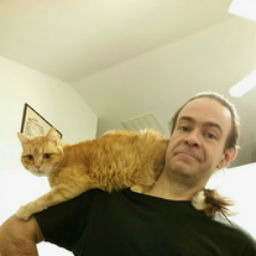Remember that this power is not entirely your own, it is— at its very core— an exchange. This is symbiosis.— Saronere
Dust refers to a genus of microscopic organisms which are attracted to living beings. The creatures swarm within them, and even grant power to a select few.
Power From Within
While every living being within the solar system is host to some amount of dust— very few are able to utilize it. For reasons yet to be understood by even the system's greatest minds, the creatures prefer those whose bodies emit a particular electric signal, known as the
Raesh Signal. This can be
detected by scientists, but only
one has ever managed to recreate it— the results dissuading most from following in their footsteps.
Only
humans have been known to possess the elusive signal, and those who do are born with it. This will lie dormant within them until a moment of great fear or anger activates it— followed shortly by the voice of
Saronere, who teaches them how to control the dust within them. Those with this ability are known as
dusters— and can be found throughout the system as revered heroes, hated villains, and even as outcasts.
Custom Made
How, exactly, one's power can manifest varies wildly from duster to duster, and is typically limited to a singular ability. This ability can be versatile, however. For example, one duster may be able to create "bubbles" from dust— allowing them to create cushions, float into the air, or fix handholds onto a flat surface. Another duster could possess the ability to create a dust "magnet" which uses tendrils of dust to collect and tie together objects.
Regardless of a duster's particular ability— they require a
focus to use it in any great capacity— a mechanical apparatus that quite literally focuses dust through it. These are often custom-made for each duster, as each controls and expels dust through different parts of their body. Beyond their initial ability, dusters can also manipulate dust in a limited fashion, through basic movements such as flight, tightening, and loosening.
Color & Appearance
Interestingly, the color of dust varies from duster to duster— rather than depending on species. For all, however, it appears as a fantastical collection of tiny, glowing, particles.
Akin to dust— hence the name.
Their appearance can vary from species to species, however. For example— gauhr'ol swarms appear to be made of finer particles than others, while rox are visibly larger.
The children ask me every time I land back home, and I always indulge them. Tracing colorful patterns in the sky, I can't help but stare in awe alongside them.— A content duster
Limitations
As the dust within one's body is limited— and the creatures can only procreate so quickly— there is a limit to how much any duster is able to do in a single day. Each ability requires a different amount of dust, and can be used at variable sizes— so each duster must become accustomed to their own limits. Thankfully, one cannot easily remove all the dust from their body, as at least a small swarm— known as the
core— will still reside in their brains.
It is this core that allows one to control dust to begin with, acting as a translation center of sorts that takes commands from the duster's brain signals and passes them along to the rest of the swarm. In particularly desperate cases, the core can still be coaxed out and controlled with extra concentration, but doing so will leave the duster dead within minutes— as cores tend to intertwine themselves with their hosts' grey matter.
A Million Voices
Saronere is an entity met by all dusters, typically at the moment of their activation. Saronere is not seen, they are rather heard, and felt. Only dusters can hear them, as Saronere cannot be met secondhand.
They seldom speak, but when they do— they do so with a million voices at once, as if every past duster spoke through them.
They are a guide to each duster, teaching them how to use their powers— and occasionally about the world around them.
How long recovery takes varies on the amount of dust used, taking anywhere from minutes to days for a duster to replenish their dust. New dust is not grown within them, rather, new swarms find their way into a duster's body— some even returning from previous use. Dusters can still exert control over dust outside of their bodies, however, and in moments of desperation, can force dust into themselves. Though, this often leads to notable scarring— and in extreme cases, fatal injuries.
A Cruel Art
Dust is found in many places, but only one is forbidden— those found in living beings. This is not because dust gives life— it has been proven time and time again that life can persist without the creatures. No, to extract it from a living being is a violent, terrible act— one which pulls the creatures through a victim's body with more than enough force to kill. Thousands of tiny holes litter their bodies, now macabre meshes of flesh and blood.
A steady hand will maim their victims at best— leaving twisted scars in their wake if not deadly complications.
Dust Species
There are a variety of dust species— each with different properties— leading to certain classes of duster abilities. Exactly which species resides within any particular duster depends on that of their core— simply put, the first to find a home within their bodies will determine those they can control. There are noted cases of mixed species, but these are few and far between— most dusters will be host to one of the following:
Trugana
Tough outer shells allow dusters to create hard, protective surfaces.
Rox
The largest species, barely able to fly. Their thick, heavyset builds allow users to create dense objects— like walls or weapons.
Zzolin
Vibrations allow their dusters greater control and range of temperature.
Heo
Lightweight physiology allows dusters to control light yet hardy swarms, often allowing flight.
A'ilo
Flexible interlocking bodies allow dusters to control tough thread-like swarms.
Gauhr'ol
The smallest, able to fit closely together, allowing their users to control liquid-like abilities.






Ooo this is such an interesting idea - so it's basically like a magic system, only... living. The description of what happens if you extract dust from someone was visceral. Great job! The phrase 'varies [wildly] from duster to duster' is used twice and it hooked my brain a little on the read-through. Just an observation.
Explore Etrea
Thank you!